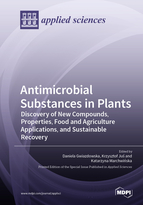Antimicrobial Substances in Plants: Discovery of New Compounds, Properties, Food and Agriculture Applications, and Sustainable Recovery
A special issue of Applied Sciences (ISSN 2076-3417). This special issue belongs to the section "Food Science and Technology".
Deadline for manuscript submissions: closed (10 November 2021) | Viewed by 18696
Special Issue Editors
Interests: design and quality assessment of bioactive food; probiotic preparations; biological detoxification of mycotoxins
Special Issues, Collections and Topics in MDPI journals
Interests: design and effectiveness assessment of biological control agents against mycotoxigenic fungi in food chain
Special Issues, Collections and Topics in MDPI journals
Interests: quality assessment and functional properties of fermented food waste, bioactive products and probiotic formulations
Special Issues, Collections and Topics in MDPI journals
Special Issue Information
Dear Colleagues,
Microbial contamination of agriculture and food commodities may cause significant losses, with economic, social and environmental consequences. Therefore, the search for new promising substances demonstrating antagonism towards different microorganisms has been observed in recent years. Plants are a valuable source of different bioactive compounds exhibiting antimicrobial activity. These substances usually play a role as a defense factor against different microorganisms and predators, as well as acting as growth regulators. Plant antimicrobials are varied in their chemical nature and include different compounds, such as phenolic compounds, terpenoids and essential oils, alkaloids, lectins and polypeptides. Due to the high diversity of their structure and properties, these substances may be applied against bacteria and fungi in the whole food chain, including pathogens and spoilage microorganisms. Taking into account the increased interest in natural antimicrobials, plant metabolites seem to be an important alternative for chemical pesticides in plant protection, as well as for preservatives in food or food packaging. Therefore, research on the discovery of new substances and their antimicrobial activity against bacteria and toxigenic fungi occurring in food and food processing, as well as those responsible for plant infections during their growth, will expand our knowledge about plant metabolites. Considering that the majority of research concerns planktonic cells, the activity of plant antimicrobials should be equally important in relation to biofilms formed by pathogenic and spoilage microorganisms. Moreover, papers covering the implementation of new technologies, as well as the sustainable recovery of antimicrobial substances from waste materials, are also welcome.
Prof. Dr. Gwiazdowska Daniela
Dr. Krzysztof Juś
Dr. Katarzyna Marchwińska
Guest Editors
Manuscript Submission Information
Manuscripts should be submitted online at www.mdpi.com by registering and logging in to this website. Once you are registered, click here to go to the submission form. Manuscripts can be submitted until the deadline. All submissions that pass pre-check are peer-reviewed. Accepted papers will be published continuously in the journal (as soon as accepted) and will be listed together on the special issue website. Research articles, review articles as well as short communications are invited. For planned papers, a title and short abstract (about 100 words) can be sent to the Editorial Office for announcement on this website.
Submitted manuscripts should not have been published previously, nor be under consideration for publication elsewhere (except conference proceedings papers). All manuscripts are thoroughly refereed through a single-blind peer-review process. A guide for authors and other relevant information for submission of manuscripts is available on the Instructions for Authors page. Applied Sciences is an international peer-reviewed open access semimonthly journal published by MDPI.
Please visit the Instructions for Authors page before submitting a manuscript. The Article Processing Charge (APC) for publication in this open access journal is 2400 CHF (Swiss Francs). Submitted papers should be well formatted and use good English. Authors may use MDPI's English editing service prior to publication or during author revisions.
Keywords
- Antimicrobial
- food
- food safety
- plant protection
- packaging
- biofilm
- sustainable recovery.








